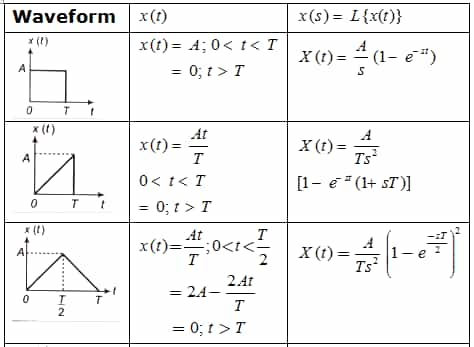Laplace Transform
The Laplace Transform is a very important tool to analyse any electrical containing by which we can convert the Integral-Differential Equation in Algebraic by converting the given situation in Time Domain to Frequency Domain
 is also called bilateral or two-sided Laplace transform.
is also called bilateral or two-sided Laplace transform.- If x(t) is defined for t≥0, [i.e., if x(t) is causal], then
 is also called unilateral or one-sided Laplace transform.
is also called unilateral or one-sided Laplace transform.
Below we have listed the Following advantage of accepting Laplace transform:
- Analysis of general R-L-C circuits become easier.
- Natural and Forced response can be easily analyzed.
- The circuit can be analyzed with impedances.
- Analysis of stability can be done easiest way.
Statement of Laplace Transform
- The direct Laplace transform or the Laplace integral of a function f(t) defined for 0 ≤ t < ∞ is the ordinary calculus integration problem for a given function f(t).
- Its Laplace transform is the function, denoted F(s) = L{f}(s), defined by

- A causal signal x(t) is said to be of exponential order if a real, positive constant σ (where σ is the real part of s) exists such that the function, e- σt|X(t)| approaches zero as t approaches infinity.
- For a causal signal, if lim e-σt|x(t)|=0, for σ > σc and if lim e-σt|x(t)|=∞ for σ > σc then σc is called the abscissa of convergence, (where σc is a point on real axis in s-plane).
- The value of s for which the integral
 converges is called Region of Convergence (ROC).
converges is called Region of Convergence (ROC). - For a causal signal, the ROC includes all points on the s-plane to the right of abscissa of convergence.
- For an anti-causal signal, the ROC includes all points on the s-plane to the left of the abscissa of convergence.
- For a two-sided signal, the ROC includes all points on the s-plane in the region in between two abscissae of convergence.
Properties of the ROC
The region of convergence has the following properties
- ROC consists of strips parallel to the jω-axis in the s-plane.
- ROC does not contain any poles.
- If x(t) is a finite duration signal, x(t) ≠ 0, t1 < t < t2 and is absolutely integrable, the ROC is the entire s-plane.
- If x(t) is a right sided signal, x(t) = 0, t1 < t0, the ROC is of the form R{s} > max {R{pk}}
- If x(t) is a left sided signal x(t) = 0, t1 > t0, the ROC is of the form R{s} > min {R{pk}}
- If x(t) is a double-sided signal, the ROC is of the form p1 < R{s} < p2
- If the ROC includes the jω-axis. Fourier transform exists and the system is stable.
Inverse Laplace Transform
- It is the process of finding x(t) given X(s)
X(t) = L-1{X(s)}
There are two methods to obtain the inverse Laplace transform.
- Inversion using Complex Line Integral

- Inversion of Laplace Using Standard Laplace Transform Table.
Note A: Derivatives in t → Multiplication by s.

B: Multiplication by t → Derivatives in s.

Laplace Transform of Some Standard Signals




Some Standard Laplace Transform Pairs




Properties of Laplace Transform



Key Points
- The convolution theorem of Laplace transform says that Laplace transform of convolution of two time-domain signals is given by the product of the Laplace transform of the individual signals.
- The zeros and poles are two critical complex frequencies at which a rational function of a takes two extreme value zero and infinity respectively.
You can avail of BYJU’S Exam Prep Online classroom program for all AE & JE Exams:
BYJU’S Exam Prep Online Classroom Program for AE & JE Exams (12+ Structured LIVE Courses)
You can avail of BYJU’S Exam Prep Test series specially designed for all AE & JE Exams:
BYJU’S Exam Prep Test Series AE & JE Get Unlimited Access to all (160+ Mock Tests)
Thanks
Team BYJU’S Exam Prep
Download BYJU’S Exam Prep APP, for the best Exam Preparation, Free Mock tests, Live Classes.
 is also called bilateral or two-sided Laplace transform.
is also called bilateral or two-sided Laplace transform. converges is called Region of Convergence (ROC).
converges is called Region of Convergence (ROC).



Comments
write a comment